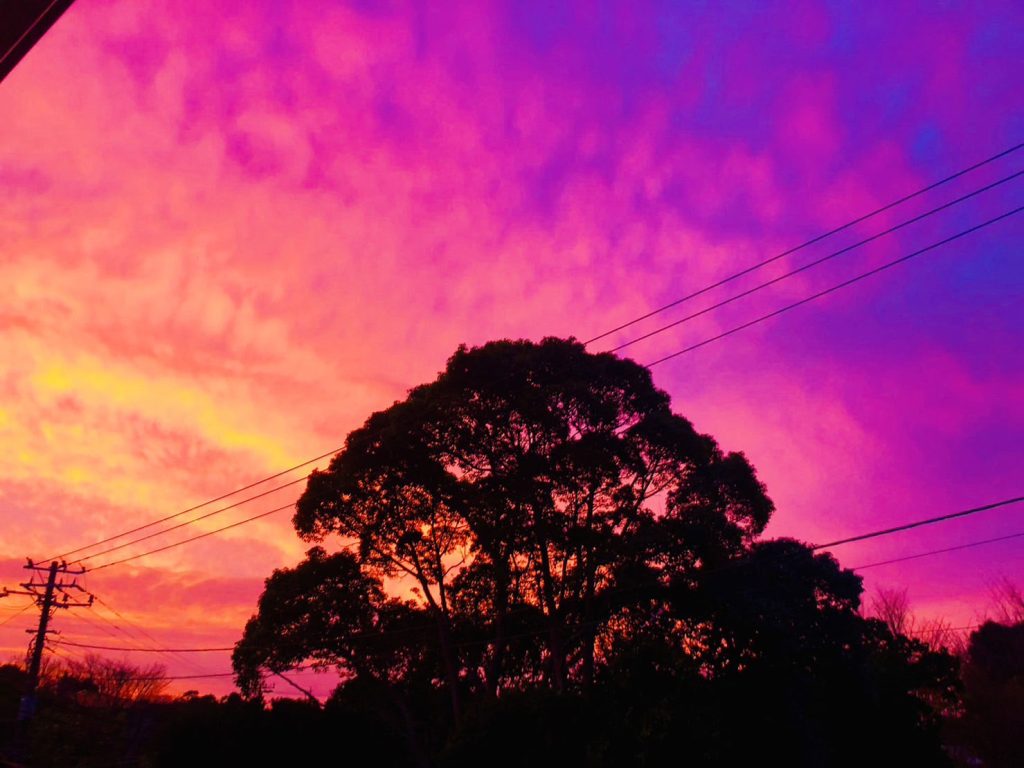
It’s a vivid morning glow. There’s a saying about the weather: ‘Red sky at night, shepherds delight; red sky in morning, shepherds take warning.’ While this saying is generally accurate, it’s not always definitive. Generally, when the morning glow transitions from pink to orange and then to yellow, the day tends to be sunny. Similarly, in the evening, when the sky is covered with clouds and the sunset turns extremely red or ominously red, it often indicates rain the next day.
In general, the vibrant colors in the sky are due to the abundance of water vapor in the air. In the morning and evening, when the sun is low, the short-wavelength ‘blue light’ scatters in the atmosphere, while the long-wavelength ‘red light’ reaches the ground without much scattering. When there’s a considerable amount of water vapor in the air, it scatters just enough, making it more visible to the eye. Particularly during the rainy season, when there’s an increased amount of water vapor in the air, the chances of having vibrant morning and evening glows are higher.
The saying ‘Red sky at night, shepherds delight; red sky in morning, shepherds take warning’ is applicable mainly during the seasons of spring and autumn when there’s a tendency for mobile high-pressure systems alternating with low-pressure systems. It’s not very reliable during winter or summer. This saying is most accurate during the seasons of spring and autumn when there’s a higher likelihood of the formation of migratory high-pressure systems caused by the alternating passage of high and low-pressure areas.
By the way, it was recently reported that the Northern Lights were visible in Hokkaido after several decades. This phenomenon is different from morning and evening glows and is attributed to increased solar activity.
色鮮やかな朝焼けです。「朝焼けは雨、夕焼けは晴れ」というお天気のことわざがありますが、概ねは当たっていますが、一概には言えません。朝焼けも、ピンク色からオレンジ色、そして黄色へと、順に明るい色に変わっていく日は晴れることが多く、夕焼けも、雲がかかっていて、極端な赤色、不気味な赤色となると翌日は雨になることが多いです。
一般的に、空が濃く鮮やかな色に染まるのは、空気中の水蒸気が多いことが要因です。朝と夕方は太陽高度が低く、波長の短い「青い光」は空気中に散乱しますが、波長の長い「赤い光」はあまり散乱されずに地上に届きます。そして、空気中に水蒸気が多いと、適度に散乱し、目に入って来やすくなるのです。特に、梅雨時期は空気中に水蒸気が多くなっているため、より鮮やかな朝焼けや夕焼けになる可能性が高くなります。
「朝焼けや雨、夕焼けは晴れ」が当たるのは春と秋のみの季節限定ネタで、冬や夏はあまり当てになりません。このことわざがよく当たるのは、高気圧と低気圧が交互に通過する移動性高気圧が発生し易い春と秋に限るわけです。
ちなみに、つい最近、北海道で何十年ぶりにオーロラが見えたそうですが、これは朝焼けや夕焼けと違って、太陽活動が活発になったせいです。
